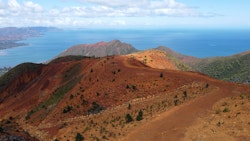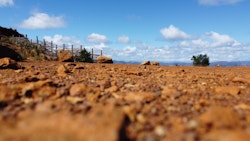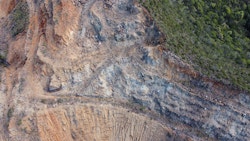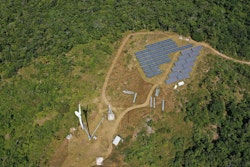New Caledonia: a considerable carbon footprint
While our vessel and its crew continue the Odyssey in New Caledonia, let’s discover more about the energy issues facing the archipelago. Between an incredibly rich biodiversity and an important carbon footprint, Katia Nicolet, marine biologist, tells us more about the beauties and challenges of this territory that is home of 25% of the nickel resources in the world.

A unique archipelago
New Caledonia is a French archipelago in the Pacific Ocean with a unique status that allows for a greater independence. For example, the islands have their own currency, the Pacific Franc, and not the Euro. Geographically, New Caledonia is a neighbour to the island nation of Vanuatu (~300 km), Australia (~1 200 km) and New Zealand (~1 400 km), and is about 17 000 km away from Metropolitan France.
New Caledonia has a population of over 270, 000 habitants, mainly located in the capital, Noumea, on the largest island called “Grande Terre” (big land). The islands were populated about 3, 200 years ago by Melanesians, who still represent about 39% of the current population. The Europeans immigrated to New Caledonia in the late 1800s and constitute about 27% of the population today. More recently, populations from Wallis and Futuna, Vanuatu, Indonesia, Tahiti and Vietnam have also settled in New Caledonia.

Geology and biodiversity
This archipelago is a mix of continental crust (from the mainly submerged continent of Zealandia) and coralline atolls, which explains the high level of endemism of the region and the diversity of species found there. 74% of plant species in New Caledonia are found nowhere else in the world, and the same is true for 95% of its reptile species and 23 species of birds. This rich and unique habitat is unfortunately not translated into productive agricultural land. The only significant agricultural production is yam, taro, plantain and coconut. As a result, New Caledonia has to import about $4 billion US worth of goods and services each year, ~20% of which are food imports.

An archipelago relying at 97% on fossil fuels
The most important import to New Caledonia is refined petroleum and coal, from Singapore, South Korea and Australia. Indeed, the archipelago is still highly dependent on fossil fuels with only 20% of electricity sourced from renewable energies. The large majority of electricity production comes from thermal power stations (fuel and coal), well ahead of hydropower, solar and wind power plants. New Caledonia dependency for fossil fuel also comes from the use of non-renewable gas for cooking and from the lack of decarbonised transports (land, sea and air transport). All sectors combined, the archipelago relays at 97% on fossil fuels.
A useful metric to understand a region’s energy balance and related carbon emissions is the per capita CO2 emission. Very simply, it is the amount of CO2 (in tonne) emitted by the country (or region) in a year, divided by the number of inhabitants. New Caledonia, in 2020, had a 20.27 tonnes per capita CO2 emission, more than the amount of CO2 per capita of Saudi Arabia (18 tonnes). Metropolitan France, as a comparison, “only” emitted 5.3 tonnes of CO2 per person in 2017 (all sources: Our World in Data, the Global Carbon Project, Agence Calédonienne de l’Energie). More alarming yet, whilst most countries in the world are reducing their carbon emissions per capita, New Caledonia has doubled the amount of CO2 emission per person in twenty years (was 10.2 tonnes in 2000).

A very energy-consuming nickel production
The energy production and the transport industry for local demands cannot explain such a high greenhouse gas emission per person. To understand this, we must look at the main exports: ferroalloys and nickel. As it turns out, New Caledonia has 25% of all nickel resources in the world, and the mining and exporting of this good is the backbone of its economy. The three actual nickel mines are located on Grande Terre, and the mining industry is responsible for 77% of all the energy consumption of the archipelago (only 23% for domestic use). In addition to the largely energy consumption of the industry, the mines also use coal and propane to extract and transform the nickel ore. As a result, 84% of all greenhouse gases are emitted by the mining industry and the transport sector. 8,6% are emitted by the agricultural sector and the residential and tertiary sector only accounts for 1,6% of all greenhouse gases emissions (source: Direction de l’Industrie, des Mines et de l’Energie de la Nouvelle-Calédonie).
Unfortunately, even in 2021, the emphasis is put on the residential and tertiary sector when it comes to switching the renewable energies. Soon, all houses will be powered by solar, wind and hydropower, but the amount of CO2 emissions will continue to rise. As of today, the mining companies are exonerated from carbon taxes and set their own targets for greenhouse gases emissions. The Plan for the Energy Transition of New Caledonia (Schéma pour la transition énergétique de la Nouvelle-Calédonie) has set the target of reducing the CO2 emissions in the residential sector by 35% by 2030, but only by 10% for the mining industry and 15% for the transport sector.

Combining economic and sustainable development
Considering the last IPCC report and the strong warning from the scientific community, a lot more needs to be done today to avoid the worst effects of climate change. An industry of this size cannot continue to burn petroleum fuels and coal, transported by ships from countries 7 500 km away, only to extract an ore that will be shipped out again on polluting ships. Some mining companies, however, are looking at cleaner energy sources (solar and hydropower) and extraction techniques less impactful for the environment. The fast-growing market for lithium-ion batteries, requiring nickel for their production, is also pushing the industry towards a more ecologically minded market. Furthermore, nickel is a mineral that can be recycled almost indefinitely, allowing for interesting solutions in the near future.